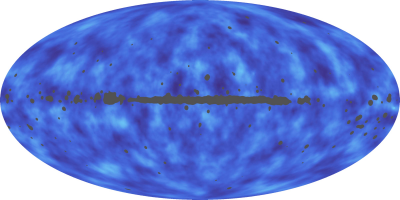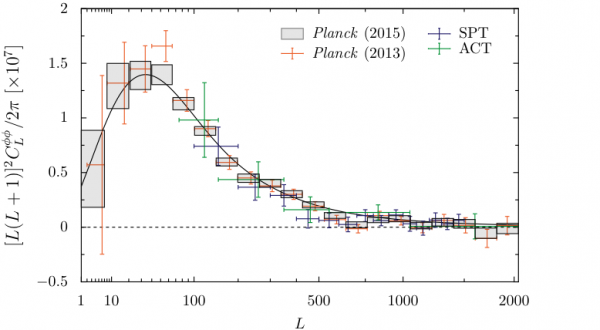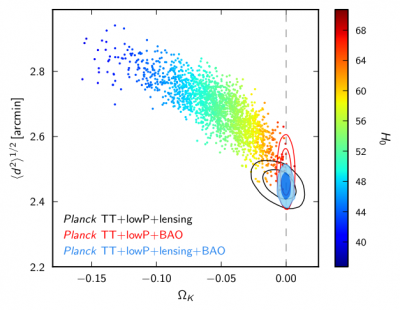As CMB photons propagate freely from the time of recombination (when hydrogen atoms first formed, and the CMB decoupled from matter), they are gravitationally deflected by the large-scale distribution of matter in the Universe. Just as a glass lens can bend light, focusing or spreading the rays, large gravitational masses can similarly distort the path of the CMB photons.
This lensing effect leaves subtle imprints in the temperature and polarization anisotropies, which can be used to reconstruct a map of the lensing potential whose gradient determines the lensing deflections. For example, in propagating through a large overdense clump of matter on the line of sight, angular structures in the CMB get magnified appearing bigger on the sky. Essentially, by looking how the typical size of hot and cold spots in the CMB temperature map vary across the sky, we can reconstruct the lensing deflections and hence the integrated distribution of dark matter. The lensing map reconstructed from the Planck 2015 data is shown below.

Figure: All-sky map of the CMB lensing potential constructed from the Planck 2015 data. Lighter regions correspond to integrated overdensities, darker to underdensities. The grey regions, where Galactic and extragalactic foregrounds are large, are masked in the analysis. (Image credit: ESA and the Planck Collaboration.)
The lensing map provides a new cosmological observable, similar to maps of cosmic shear estimated from the shapes of galaxies. Its power spectrum (see below) provides access to cosmological parameters from the CMB alone that affect the late-time expansion and geometry of the Universe, and the growth of structure — parameters that have only degenerate effects in the primary CMB anisotropies.

Figure: Power spectrum of the CMB lensing potential estimated from the 4-point function of the Planck 2015 temperature and polarization maps (grey boxes), compared with the theoretical expectation for the LCDM model with parameters determined from the Planck measurements of the CMB power spectra. Also shown are the Planck 2013 lensing results (orange), and results from the ground-based experiments SPT (blue) and ACT (green). (Image credit: ESA and the Planck Collaboration.)
The good agreement between the LCDM predictions from the Planck power spectra, and the measured lensing spectrum shown above, is a powerful test of the model: the clustering of matter at redshift z=2 (where CMB lensing is most efficient) is consistent with that predicted from the statistics of the CMB fluctuations at z=1100. Given the consistency with LCDM, the lensing measurements constrain some extensions tightly. For example, the curvature of space is constrained to be flat at better than 1% (68% confidence) by combining the power spectra of the anisotropies and lensing from Planck (see figure below).

Figure: Constraints on the spatial curvature and the rms amplitude of the lensing deflection from the power spectrum of the Planck 2015 temperature anisotropies and large-angle polarization (samples, colour-coded by the Hubble constant). The “geometric degeneracy” allows models with significant curvature to fit the CMB power spectra, but such models have a large lensing signal which is inconsistent with the Planck lensing measurement. Combining the observables gives the black contours, which tightly constrain the curvature. The geometric degeneracy can also be broken with baryon acoustic oscillation data (BAO; red contours) from SDSS and 6dF. The combination of all three observables is shown as the solid blue contours. (Image credit: ESA and the Planck Collaboration.)
With Planck, most of the lensing information comes from the temperature anisotropies. This situation will change as more sensitive, high-resolution polarization observations are made, initially with ground-based experiments and potentially from space in the future. Such observations may measure around 105 lensing modes with high signal-to-noise, extracting essentially all information from the CMB lensing effects on scales where the expected signal can be reliably predicted with linear perturbation theory. These CMB lensing measurements will be a very powerful and clean probe of large-scale structures at relatively high redshift, and will be very complementary to cosmic shear measurements from galaxy shapes.


